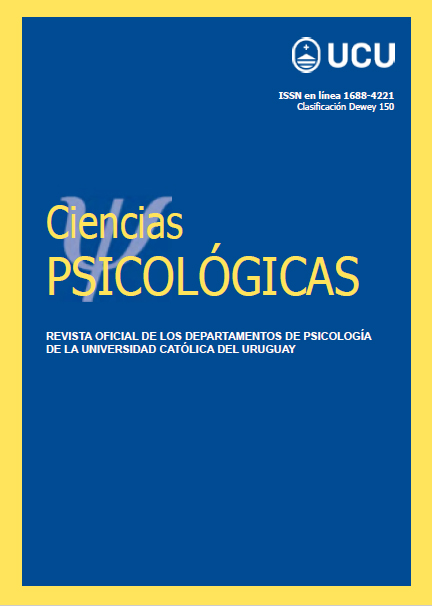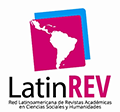Intervenções antibullying com adolescentes: uma mapping review
DOI:
https://doi.org/10.22235/cp.v19i2.4658Palavras-chave:
psicologia escolar, violência escolar, adolescência, intervençãoResumo
O bullying e o cyberbullying são fenômenos problemáticos de grupo que afetam a saúde e o desenvolvimento dos adolescentes. Esse estudo objetivou identificar e descrever sistematicamente o conteúdo de intervenções antibullying realizadas com adolescentes. Para atender a esse objetivo foi desenvolvido uma mapping review, seguindo as recomendações PRISMA e pesquisando nas bases de dados SCOPUS, PsycINFO, PubMed e Web of Science. Um formulário de extração padronizado foi desenvolvido, sendo que todos os resultados identificados nas fontes consultadas foram exportadas para a plataforma Rayyan. Todos os títulos e resumos foram revisados na primeira etapa de triagem e, em seguida, foram recuperados os materiais na integra para constituição do corpus. Os dados foram analisados de forma descritiva e analítica. Onze estudos foram incluídos na revisão, e estes relataram 10 intervenções. Evidenciou-se uma diversidade de componentes e fundamentos teóricos presentes nas intervenções revisadas. Todas as iniciativas documentadas foram eficazes, em alguma medida, para combater o bullying e/ou cyberbullying. A participação dos próprios estudantes na condução das ações interventivas junto aos colegas foi destaque em algumas intervenções. Intervenções culturalmente relevantes foram documentadas e a abordagem participativa e integradas ao ambiente escolar foram muito valorizadas, sendo inspiração para outras intervenções.
Downloads
Referências
Ansary, N. S. (2020). Cyberbullying: Concepts, theories, and correlates informing evidence-based best practices for prevention. Aggression and Violent Behavior, 101343. https://doi.org/10.1016/j.avb.2019.101343
Aristimuño, A., & Noya, J. C. (2015). La convivencia escolar y el fenómeno del bullying en la enseñanza secundaria de Uruguay: un estudio de caso. Páginas de Educación, 8(2), 36-65. https://doi.org/10.22235/pe.v8i2.691
Best, O., & Ban, S. (2021). Adolescence: physical changes and neurological development. British Journal of Nursing, 30(5), 272-275. https://doi.org/10.12968/bjon.2021.30.5.272
Bosa, M. R., Bohórquez, M. C. C., Olarte, C. F. P., & Malaver, J. K. S. (2018). Diferencias por sexo en la intimidación escolar y la resiliência en adolescentes. Psicologia Escolar e Educacional, 22(3), 519-526. https://doi.org/10.1590/2175-35392018039914
Chaux, E., Velásquez, A. M., Schultze-Krumbholz, A., & Scheithauer, H. (2016). Effects of the cyberbullying prevention program media heroes (Medienhelden) on traditional bullying. Aggressive Behavior, 42(2), 157-165. https://doi.org/10.1002/ab.21637
Costantino, C., Casuccio, A., Marotta, C., Bono, S. E., Ventura, G., Mazzucco, W., Vitale, F., Restivo, V., & the BIAS Study Working Group (2019). Effects of an intervention to prevent the bullying in first-grade secondary schools of Palermo, Italy: the BIAS study. Italian Journal of Pediatrics, 45(65). https://doi.org/10.1186/s13052-019-0649-3
Ferreira, T. R. S. C., & Deslandes, S. F. (2018). Cyberbullying: conceituações, dinâmicas, personagens e implicações à saúde. Ciência & Saúde Coletiva, 23(10), 3369-3379. https://doi.org/10.1590/1413-812320182310.13482018
Ferrer-Cascales, R., Albaladejo-Blázquez, N., Sánchez-SanSegundo, M., Portilla-Tamarit, A., Lordan, O., & Ruiz-Robledillo, N. (2019). Effectiveness of the TEI program for bullying and cyberbullying reduction and school climate improvement. International Journal of Environmental Research and Public Health, 16(4). https://doi.org/10.3390/ijerph16040580
Flay, B. R., Biglan, A., Boruch, R. F., Castro, F. G., Gottfredson, D., Kellam, S., Mościcki, E. K., Schinke, S., Valentine, J. C., & Ji, P. (2005). Standards of evidence: criteria for efficacy, effectiveness and dissemination. Prevention Science: the Official Journal of the Society for Prevention Research, 6(3), 151-175. https://doi.org/10.1007/s11121-005-5553-y
Gaffney, H., Ttofi, M. M., & Farrington, D. P. (2021). What works in anti-bullying programs? Analysis of effective intervention components. Journal of School Psychology, 85, 37-56. https://doi.org/10.1016/j.jsp.2020.12.002
Galvão, T. F., Tiguman, G. M. B., & Sarkis-Onofre, R. (2022). A declaração PRISMA 2020 em português: recomendações atualizadas para o relato de revisões sistemáticas. Epidemiologia e Serviços de Saúde, 31(2), e2022364. https://doi.org/10.1590/SS2237-9622202200011
Garaigordobil, M., & Martínez-Valderrey, V. (2015). Effects of Cyberprogram 2.0 on “face-to-face” bullying, cyberbullying, and empathy. Psicothema, 27(1), 45-51. https://doi.org/10.7334/psicothema2014.78
Garcés-Prettel, M., Santoya-Montes, Y., & Jiménez-Osorio, J. (2020). Influencia de la comunicación familiar y pedagógica en la violencia escolar. Comunicar, 28(63), 77-86. https://doi.org/10.3916/C63-2020-07
Hosozawa, M., Bann, D., Fink, E., Elsden, E., Baba, S., Iso, H., & Patalay, P. (2021). Bullying victimisation in adolescence: prevalence and inequalities by gender, socioeconomic status and academic performance across 71 countries. EClinicalMedicine, 41, 101142. https://doi.org/10.1016/j.eclinm.2021.101142
Hultin, H., Ferrer-Wreder, L., Engström, K., Andersson, F., & Galanti, M. R. (2021). The importance of pedagogical and social school climate to bullying: A cross-sectional multilevel study of 94 Swedish schools. The Journal of School Health, 91(2), 111-124. https://doi.org/10.1111/josh.12980
Ingram, K. M., Espelage, D. L., Merrin, G. J., Valido, A., Heinhorst, J., & Joyce, M. (2019). Evaluation of a virtual reality enhanced bullying prevention curriculum pilot trial. Journal of Adolescence, 71. https://doi.org/10.1016/j.adolescence.2018.12.006
Instituto Brasileiro de Geografia e Estatística. (2021). Pesquisa nacional de saúde do escolar: 2019.
Khalil, H., & Tricco, A. C. (2022). Differentiating between mapping review and scoping reviews in the evidence synthesis ecosystem. Journal of Clinical Epidemiology, 149, 175-182. https://doi.org/10.1016/j.jclinepi.2022.05.012
Lembo, V. M. R., Santos, M. A., Silva, M. A. I., Sampaio, J. M. C., & Oliveira, W. A. (2023). Imaginação e sentimentos de estudantes que praticam bullying na escola. Em Santos-Vitti, Nakano, T. C., Chnaider, J., & De Abreu I. C. C. (Orgs.), Psicologia Positiva e Desenvolvimento Humano (pp. 179-196). Vetor.
Li, C., Wang, P., Martin-Moratinos, M., Bella-Fernández, M., & Blasco-Fontecilla, H. (2024). Traditional bullying and cyberbullying in the digital age and its associated mental health problems in children and adolescents: a meta-analysis. European Child & Adolescent Psychiatry, 33(9), 2895-2909. https://doi.org/10.1007/s00787-022-02128-x
Loch, A. P., Astolfi, R. C., Leite, M. A., Papa, C. H. G., Ryngelblum, M., Eisner, M., & Peres, M. F. T. (2020). Victims, bullies and bully-victims: prevalence and association with negative health outcomes from a cross-sectional study in São Paulo, Brazil. International Journal of Public Health, 65(8), 1485-1495. https://doi.org/10.1007/s00038-020-01481-5
Malta, D. C., Oliveira, W. A., Prates, E., Mello, F., Moutinho, C., & Silva, M. (2022). Bullying among Brazilian adolescents: evidence from the National Survey of School Health, Brazil, 2015 and 2019. Revista Latino-Americana de Enfermagem, 30(spe), e3679. https://doi.org/10.1590/1518-8345.6278.3679
Martín-Criado, J. M., & Casas, J. A. (2019). Assessing the effect of the cordoba peer support program on fostering social competence and reducing the bullying. Aula Abierta, 48(2), 221-228. https://doi.org/10.17811/rifie.48.2.2019.221-228
Menesini, E., Palladino, B. E., & Nocentini, A. (2016). Noncadiamointrappola! [Let's not fall into the trap!]: Online and school-based program to prevent cyberbullying among adolescents. Em T. Völlink, F. Dehue, & C. McGuckin (Eds.), Cyberbullying: From theory to intervention (pp. 156-175). Routledge/Taylor & Francis Group.
Ng, E. D., Chua, J. Y. X., & Shorey, S. (2022). The effectiveness of educational interventions on traditional bullying and cyberbullying among adolescents: a systematic review and meta-analysis. Trauma, Violence & Abuse, 23(1), 132-151. https://doi.org/10.1177/1524838020933867
Olweus, D. (2013). School bullying: development and some important challenges. Annual Review of Clinical Psychology, 9(1), 751-780. https://doi.org/10.1146/annurev-clinpsy-050212-185516
Ortega-Barón, J., Buelga, S., Ayllón, E., Martínez-Ferrer, B., & Cava, M. J. (2019). Effects of intervention program Prev@cib on traditional bullying and cyberbullying. International Journal of Environmental Research and Public Health, 16(4). https://doi.org/10.3390/ijerph16040527
Ouzzani, M., Hammady, H., Fedorowicz, Z., & Elmagarmid, A. (2016). Rayyan-a web and mobile app for systematic reviews. Systematic Reviews, 5(1), 210. https://doi.org/10.1186/s13643-016-0384-4
Pollock, D., Peters, M. D. J., Khalil, H., McInerney, P., Alexander, L., Tricco, A. C., Evans, C., de Moraes, É. B., Godfrey, C. M., Pieper, D., Saran, A., Stern, C., & Munn, Z. (2023). Recommendations for the extraction, analysis, and presentation of results in scoping reviews. JBI Evidence Synthesis, 21(3), 520-532. https://doi.org/10.11124/JBIES-22-00123
Resett, S., & Mesurado, B. (2021). Bullying and cyberbullying in adolescents: A meta-analysis on the effectiveness of interventions. Em P. Á. Gargiulo & H. L. Mesones Arroyo (Eds.), Psychiatry and neuroscience update: From epistemology to clinical psychiatry (pp. 445-458). Springer Nature Switzerland AG. https://doi.org/10.1007/978-3-030-61721-9_32
Rey, R. D., Casas, J. A., & Ortega, R. (2016). Impact of the ConRed program on different cyberbulling roles. Aggressive Behavior, 42(2), 123-135. https://doi.org/10.1002/ab.21608
Salem, A. A. M. S., Al-Huwailah, A. H., Abdelsattar, M., Al-Hamdan, N. A. H., Derar, E., Alazmi, S., Al-Diyar, M. A., & Griffiths, M. D. (2023). Empathic Skills Training as a Means of Reducing Cyberbullying among Adolescents: An Empirical Evaluation. International Journal of Environmental Research and Public Health, 20. https://doi.org/10.3390/ijerph20031846
Schultze-Krumbholz, A., Schultze, M., Zagorscak, P., Wölfer, R., & Scheithauer, H. (2016). Feeling cybervictims' pain-The effect of empathy training on cyberbullying. Aggressive Behavior, 42(2), 147-156. https://doi.org/10.1002/ab.21613
Silva, J. L., Oliveira, W. A., Bono, E. L., Dib, M. A., Bazon, M. R., & Silva, M. A. I. (2016). Associações entre bullying e conduta infracional: revisão sistemática de estudos longitudinais. Psicologia: Teoria e Pesquisa, 32, 81-90. https://doi.org/10.1590/0102-37722016012241081090
Sorrentino, A., Sulla, F., Santamato, M., Cipriano, A., & Cella, S. (2023). The efficacy of the Tabby Improved Prevention and Intervention Program in reducing cyberbullying and cybervictimization among students. International Journal of Environmental Research and Public Health, 20. https://doi.org/10.3390/ijerph20085436
Sun, W. H., Miu, H. Y. H., Wong, C. K. H., Tucker, J. D., & Wong, W. C. W. (2018). Assessing participation and effectiveness of the peer-led approach in youth sexual health education: Systematic review and meta-analysis in more developed countries. Journal of Sex Research, 55(1), 31-44. https://doi.org/10.1080/00224499.2016.1247779
Tristão, L. A., Silva, M. A. I., de Oliveira, W. A., dos Santos, D., & da Silva, J. L. (2022). Bullying e cyberbullying: Intervenções realizadas no contexto escolar. Revista de Psicología, 40(2), 1047-1073. https://doi.org/10.18800/psico.202202.015
Wingate, V. S., Minney, J. A., & Guadagno, R. E. (2013). Sticks and stones may break your bones, but words will always hurt you: A review of cyberbullying. Social Influence, 8(2-3), 87-106. https://doi.org/10.1080/15534510.2012.730491
Zambuto, V., Palladino, B. E., Nocentini, A., & Menesini, E. (2019). Why do some students want to be actively involved as peer educators, while others do not? Findings from NoTrap! Anti-bullying and anti-cyberbullying program. European Journal of Developmental Psychology, 16(4), 373-386. https://doi.org/10.1080/17405629.2017.1419954
Zambuto, V., Palladino, B. E., Nocentini, A., & Menesini, E. (2020). Voluntary vs nominated peer educators: A randomized trial within the NoTrap! Anti-Bullying Program. Prevention Science: the Official Journal of the Society for Prevention Research, 21(5), 639-649. https://doi.org/10.1007/s11121-020-01108-4
Zhu, C., Huang, S., Evans, R., & Zhang, W. (2021). Cyberbullying among adolescents and children: a comprehensive review of the global situation, risk factors, and preventive measures. Frontiers in Public Health, 9, 634909. https://doi.org/10.3389/fpubh.2021.634909
Downloads
Publicado
Como Citar
Edição
Secção
Licença
Direitos de Autor (c) 2025 Ciencias Psicológicas

Este trabalho encontra-se publicado com a Licença Internacional Creative Commons Atribuição 4.0.
















